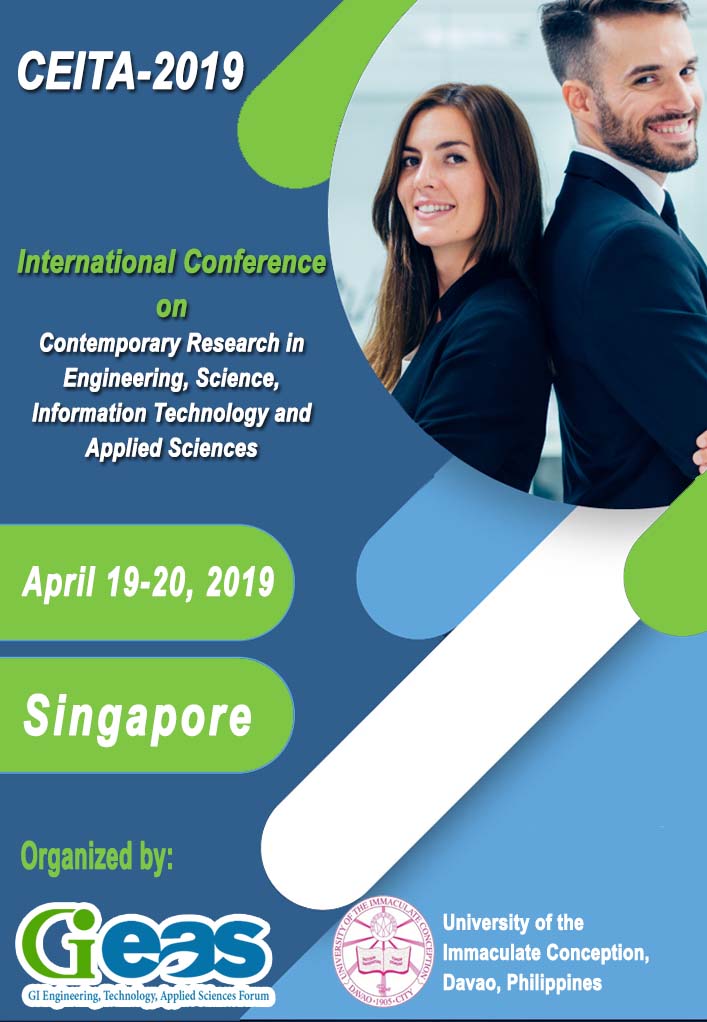
CEITA Proceedings
CEITA Proceeding
Volume 1, Pages 1-30
International Conference on
Contemporary Research in Engineering, Science, Information Technology and Applied Sciences (CEITA-APRIL-2019)
April 19-20, 2019 Singapore
Edited by Dr. Ahmed Saddam
Track: Business Management and Economic Studies
SMEs’ Activities According To Dimensions of Entrepreneurial Marketing
Pages 1-5
Thirarut Worapishet
Abstract
The paper aims to illustrate actual practices of small and medium enterprises (SMEs) according to Entrepreneurial Marketing (EM) concept encouraging growth and performance. There are seven dimensions in this concept includes proactiveness, opportunity-focused, calculated risk taking, innovation-oriented, customer intensity, resource leveraging, and value creation. Purposive sampling is used to select a Thai premium restaurant to be a case study. Data is collected by in-depth interview and analyzed with content analysis. This restaurant shows several activities characterizing 7 dimensions. Managerial implication is that SMEs can adopt activities in the case study to provoke new ideas to perform in line with EM. Academic implication is that several existing research papers study about the degree of dimensions effecting growth and performance but do not study how to perform activities. This paper values in fulfilling this lacking.
Relationship between Istiqamah and Job Satisfaction with Organizational Commitment to Employees of Call Center Banking in City X
Pages 06-10
Dzikri Hijriarahmah, Fatkhuriah
Abstract
Track: Social Sciences and Humanities
Academe’s Role in the Community-Based Rehabilitation and Aftercare Program (Cbrap): A Sequential Exploratory Approach
Pages 11-23
Nelca Stephany Umblero-Amatong
Abstract
The war on drugs cannot be won in a linear action but rather a series of calculated and signified efforts that are tailored to circumstances. The Community-Based Rehabilitation and Aftercare Program (CBRAP) is designed to focus on the individual with the intention of treatment, rehabilitation and reintegration. In Davao City, there had been efforts to introduce and implement the CBRAP in academic institutions due to the lack of resources from the government implementers. This sequential exploratory mixed methods study investigated the roles of the academe and lived experiences of purposively selected academic leaders from six CBRAP-implementing institutions, in engaging with CBRAP activities in the qualitative phase. The data were analyzed using thematic analysis to extract the themes which were used to formulate a readiness and capability questionnaire in the quantitative phase. Academic leaders from non-CBRAP implementing higher education institutions were asked to answer the questionnaire. Factor analysis was used to identify the constructs of the data. The results of the study revealed that the readiness and capability of the academic institutions are factored on seven items: valuing the importance of a drug-free society, attitudes of academic leaders, interests to establish a drug rehabilitation program, human resource capability, supplementation of resources, community partnership, and service provider capability. Data integration points to building-confirming nature of the integrated data as expected of sequential exploratory studies. Further study is recommended to create a more reliable instrument.
Track: Engineering and Technology Studies
Risk Assessment of Heavy Metals from Edible Mushrooms
Pages 24-30
Prapat Pentamwa, Jitlada Chimmai
Abstract
This study investigated the types of edible mushrooms obtained from cultivated and wild mushrooms in Nakhon Ratchasima during the rainy season in 2013. Samples were collected at the market and street shops. The heavy metals (HMs) (Cr, Mn, Ni, Cu, As, Cd, Hg, and Pb) content in each mushroom was studied and the risk of HMs was estimated from 61 samples of 7 sampling sites. Fourteen edible cultivated mushrooms and 20 wild mushrooms species were found from Sura Nakhon Market, Mae Kim Heng Market, SUT Market, mushroom stall on the street No. 304, Wang Nam Khiao district, Pak Chong District Market, and Jakkarat district roadside shop. All mushrooms were extracted using microwave digestion and analyzed by using ICP-MS. The results showed that the total amount of HMs (Sum of Cr, Mn, Ni, Cu, As, Cd, Hg, Pb) ranged from 0.9 to 13.73 mg/kg. The highest level was found in Amanita princeps Corner & Bas at 13.73 mg/kg from Wang Nam Khiew Market. The lowest amount of HMs was found in Astraeus hygrometricus (Pers.) Morgan, 0.9 mg/kg. Comparing of edible cultivated and wild mushrooms in term of mean±SD were 4.61±2.69 mg/kg and 2.62±1.42 mg/kg. The most common HMs from high to low amount were Pb> Cr> Mn> Ni> Hg> Cd> As, respectively. The risk assessment of HMs from the cultivation and wild mushrooms of the provisional tolerable weekly intake (PTWI) is safe for consumption within a week without harm to health. The Amanita princeps Corner & Bas specie from Wang Nam Khiew district market had a PTWI value of Mercury higher than recommended by FAO / WHO (2009) with a PTWI of 0.0068 mg/kg body weight/week which is higher than recommended value of 0.005.
